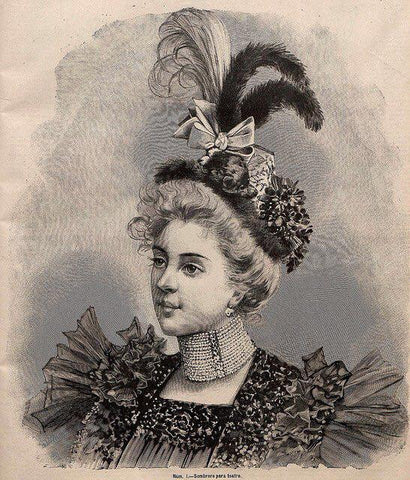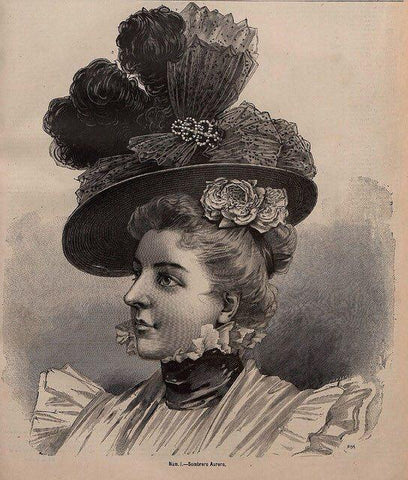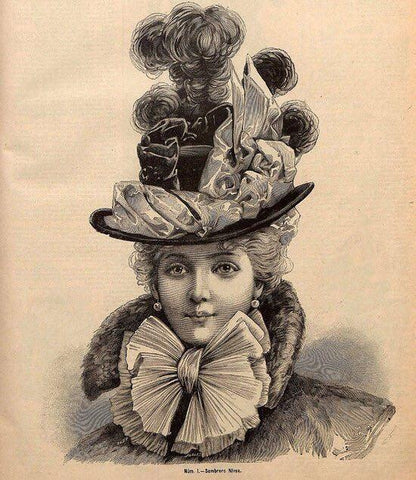Things Every Woman Should Know About Wearing Hats
by Karen
Things Every Woman Should Know About Wearing Victorian Hats
A glimpse of Kate Middleton’s most iconic formal outfits is all it takes to realize that women’s hats are slowly but surely reclaiming their role as style statement pieces. Yes, thanks to the lovely Duchess of Cambridge, ladies from all over the globe can see that women’s headwear has tremendous potential to not only protect their heads from the elements, but also to add character and drama to their looks. If you don’t believe us, feel free to take a look at some of Kate’s most memorable hat moments (thank goodness Google exists). If you’re considering the option of incorporating headwear into your outfits as a way to spice them up a bit (or a lot, depending on the headpiece), you should first learn something about the history of hats and womanhood’s passionate love affair with them. Trust us when we say this – you will be anything but bored. All right, let’s get started.
The Arrival of Headwear
As you probably suspect, it’s unknown when exactly the first hat was made. Experts believe that the very first item of headwear was created and used as protection against the elements (i.e. as sun, wind, and rain protection), which shouldn’t come as a surprise. It was most likely just a piece of animal skin puller over one’s head, so it wasn’t a hat in the true sense of the word.

A Thebes tomb is the place where one of the first pictorial depictions of a hat was found. We’re talking about a wall painting of a man wearing a coolie-style straw hat. The pileus (a simple skull cap), the Phrygian cap (also known as the ‘liberty cap’ because it was given to slaves in Greece and Rome when they were freed), and the petasos (the first known hat with a brim) are other early hats. When it comes to headwear for women, it must be said that our female ancestors were expected to cover their heads with veils, kerchiefs, hoods, caps, and wimples, which means they began wearing hats simply because society said so. During the Middle Ages, the church decreed that women’s hair was to be covered. It wasn’t until the end of the 16th century that women’s structured hats, based on those worn by the male aristocracy, that entered the picture.
The Rise & Reign of Women’s Hats
In the late 17th century, women’s headwear began to appear on the fashion stage in its own right, without being influenced by men’s hat fashions. During the very next century, milliners (i.e. makers of women’s hats) established the millinery profession. However, the term ‘milliner’ was first recorded in the year of 1529 when it referred to the products for which the Italian city Milan was well known (ribbons, gloves, and straws). Hats have played a significant role in women’s fashion for a really long period of time, but experts say that they were most popular from the 18th century to the first half of the 20th century. The size of the hat has fluctuated a lot during this time period, determining how women’s hair was cut and styled. However, hairstyles have influenced the hat choice as well. Since the Victorian era was filled with unforgettable and quite often peculiar fashion trends, we decided to dig a little bit about Victorian hats. As you probably already know, bonnets were the number one women’s headwear choice in the 1830s because this is when women liked big hair with many loops and knots. The Victorian bonnets had large crowns and were often trimmed with frills, feathers, artificial flowers, ribbons, lace, or some kind of fruit or vegetable. It’s interesting to mention that wide-brimmed bonnets were worn by both town and countryside women. Local milliners were countryside women’s favorite source of information when it came to the newest bonnet designs from Boston and New York, but they also drew inspiration from ladies’ magazines. This means that the bonnet was loved and used by women of all classes.

The main purpose of the bonnet was to shade and frame the wearer’s face while keeping her profile protected from unwanted male attention. Sometimes, soft pink linings were used as a way to add a reflective glow to the woman’s complexion. The size of the bonnet brims decreased immensely in the 1840s, but the bonnet still managed to cover most of the woman’s hair and face. Thirty to forty years later, the bonnet was picked by women who wanted a more modest appearance. This explains why eventually people began associating bonnets with a matronly look. Aside from ‘regular’ bonnets, there were also sunbonnets - Victorian hats that were worn by women while gardening or strolling in the countryside in order to preserve the favored pale complexion. Morning or breakfast caps are informal Victorian hats. These hats were worn indoors and were either extremely simple or embellished with frills and ribbons. During the first part of the 19th century, white caps were worn under outdoor Victorian bonnets as well (the goal was to create a ruffle frame around the woman’s face). Victorian hats are without a doubt some of the most fascinating women’s fashion accessories, but also some of the oddest. During the last quarter of the 19th century, bird feathers and whole birds (yes, you read that right) were some of the most wanted hat ornaments. Victorian hats for women were often decorated with wings, breasts, and entire birds (the birds were mounted on wires and springs, allowing the heads and wings to be moved about in a bird-like manner), a fashion practice that’s considered to be cruel, distasteful, and absolutely unnecessary by many people today. Aside from the above-mentioned everyday or ‘regular’ Victorian hats, there were also formal pieces of headwear. When appropriate, Victorian women donned charming evening headdresses of ribbon, lace, and drooping flowers. These headpieces added a dose of elegance, gracefulness, and femininity to the wearer’s look.

We can’t stop talking about Victorian hats without mentioning the so called ‘3-story hats’ or ‘flowerpots’. These eye-catching beauties were popular in the mid 1880s, emerging as a revival of a late 18th century women’s riding hat. These Victorian hats were very tall, looking a lot like building roofs. The Roaring Twenties were another great time period for women’s headwear. The 1920s women, particularly the flapper girls, replaced their long locks with short hairstyles like the bob and the shingle. This is why the cloche, a small, fitted hat that covered a woman’s head from just above her eyebrows to the back of her neck, became incredibly popular. The Jazz Age women often adorned their cloche with ribbons in order to relay messages to onlookers. For example, if a woman’s cloche was embellished with a firm knot, it meant that she was married, whereas a large and bold bow was a sign that the woman was single. Smart, wouldn’t you agree?
The Place of Women’s Headwear in Today’s Fashion World
Unfortunately, women’s hats are not worn universally today. The number of women who dare sport a uniquely beautiful headpiece for special dressy occasions (read weddings) or as a tiny part of their casual outfits is extremely small. Nowadays, most women (and men for that matter) perceive hats as nothing but head coverings, failing to discover their huge potential as style statement pieces. However, there’s still hope that women’s hats will regain their popularity in the near future. Why do we think so? Well, because of celebrities, of course! Lady Gaga, Björk, Kate Moss, Keira Knightley, Lily Allen, Dame Shirley Bassey, and Kate Middleton (we are deeply in love with her hat game, so we can’t help but mention her twice) are only some of the many public figures who’ve chosen to infuse themselves with a sense of freedom and individuality with the help of stunning hats, fascinators, and other types of headwear. Fortunately for hat-wearing enthusiasts, there are still a lot of talented milliners and accessories designers who believe that headwear deserves a place in the modern woman’s wardrobe. They know that women’s hats can be functional, comfortable, and gorgeous at the same time. Whether your personal style is vintage or modern, hats can complement your outfits beautifully. All you need to do is do a little research and give them a chance to seduce you. Trust us, you won’t regret it. What’s your opinion about hat-wearing? Do you let headwear grace your head every once in a while or do you avoid sporting headpieces? Feel free to share your thoughts and experiences with us in the comment section below.





















Leave a comment